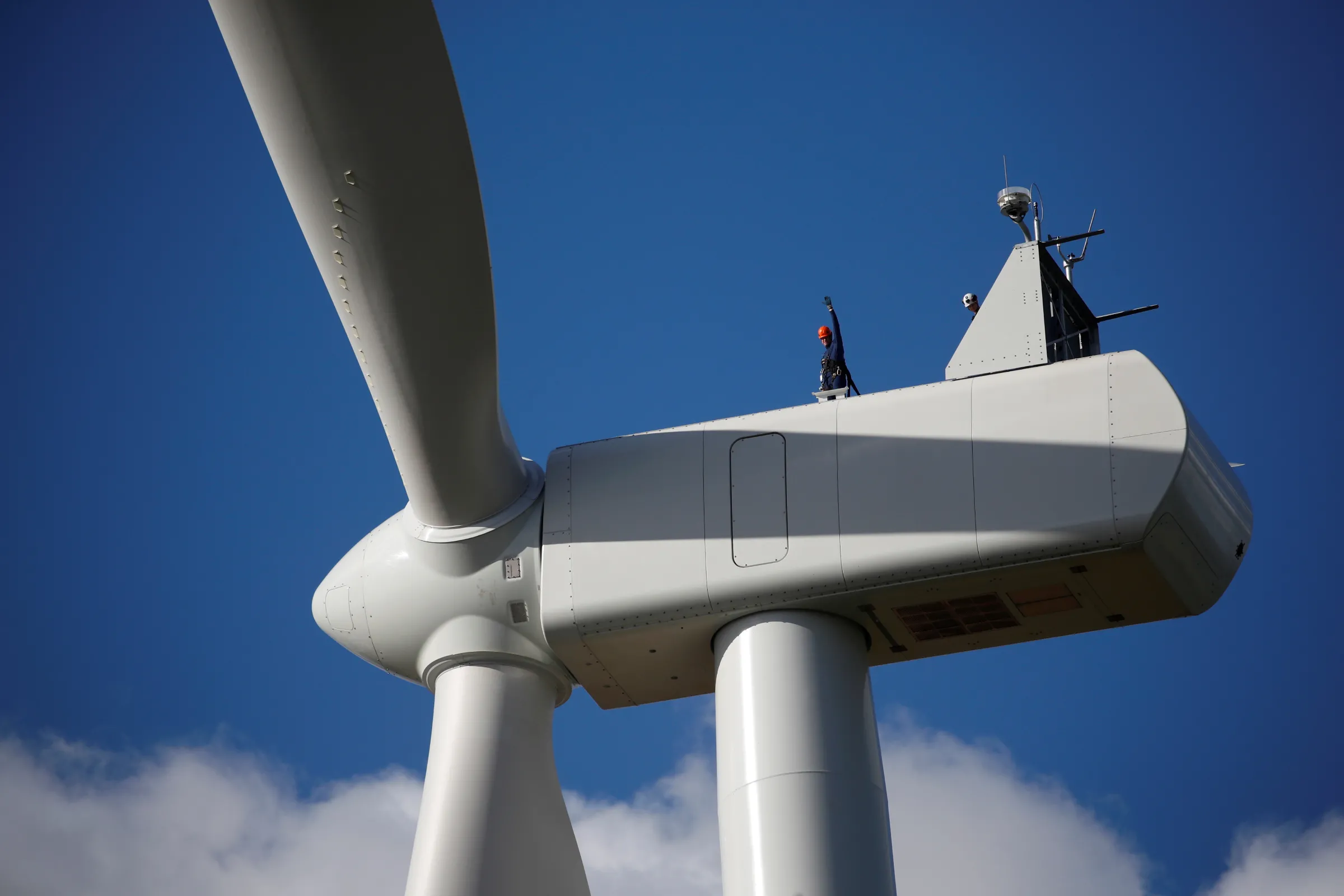Higher costs and red tape are killing Europe's renewable energy boom

A man waves as he stands on top of a power-generating windmill turbine at the Saint-Pere Energies wind farm in Saint-Pere-en-Retz near Nantes, France, October 22, 2021. REUTERS/Stephane Mahe
Europe is on the verge of a clean energy revolution, but it is difficult to roll out wind and solar energy projects.
Phil Cole is Director of Industrial Affairs at WindEurope, Aurélie Maréchal is Executive Director of Positive Money Europe, and Olof van der Gaag is Chairman of the Dutch Sustainable Energy Association (NVDE).
Working in the renewable energy sector today, you are more likely to spend time typing than with turbines.
One WindEurope member, preparing its planning application for the North Irish Sea Array Offshore Wind Farm, had to rent a delivery van just to submit the paperwork - 13 printed copies, each 13,000 pages thick.
That’s 169,000 pages to build clean, affordable power. Multiply that by thousands of projects across Europe and you get the problem: far too much red tape and too little action.
According to the International Energy Agency (IEA), in some EU member states, permitting can take up to five years for utility-scale solar PV and as long as nine years for onshore wind. This slows down deployment, even when the technology is proven and investment is available. It’s clearly incompatible with the urgency of tackling climate change.
But while these bottlenecks persist, the global transition is accelerating. According to Ember Energy, renewable energy has now overtaken coal as the world’s largest source of electricity. The IEA expects global renewable capacity to more than double by 2030.
Alongside the levels of bureaucracy involved, another obstacle gets far too little attention: the cost of money itself. That’s where Europe’s big public banks, like the European Central Bank (ECB) and the European Investment Bank (EIB), could make all the difference by making investment cheaper and less risky.
Renewable projects require major initial investment but have almost no operating costs. This makes renewable energy extremely vulnerable to interest rate changes, while fossil fuel projects are less affected.
A study by consultancy Berenschot, commissioned by the Dutch Renewable Energy Association (NVDE), found that higher interest rates could add €163 billion ($189 billion) to the Netherlands’ energy transition costs up to 2050.
The irony is that fossil fuel prices were one of the main drivers of the inflation that led to those higher rates in the first place. By contrast, renewable energy - once built - delivers stable, low-cost power for decades.
The IEA estimates the average energy price in 2023 would have been 15% higher without the additional renewables installed after the war in Ukraine.
Investing in clean energy is one of the best ways to protect against inflation and energy crises. Clearly, if Europe remains dependent on imported fossil fuels, another crisis is only a matter of time.
Since 2022, high energy prices have squeezed households, undermined industrial competitiveness, and widened our trade deficit. While prices have fallen from their peak, EU electricity costs remain above both historic averages and those of our competitors.
Yet fossil fuels continue to receive vast explicit and implicit subsidies worldwide - amounting to trillions of euros annually, according to the International Monetary Fund IMF.
These subsidies keep dirty energy cheap. In contrast, public support for clean energy is far smaller and largely aimed at correcting market failures.
Alongside stronger public support for clean technologies, Europe can also boost the sector by lowering financing costs for renewables, upgrading grids, and creating stable investment conditions - measures that make every euro of support go further.
That’s why the ECB and EIB must become allies, not bystanders, in the clean energy race.
The ECB, whose mandate includes both price stability and support for the EU’s wider economic goals, should introduce lower rates for loans that finance renewable energy, grids and efficiency upgrades.
If Europe remains dependent on imported fossil fuels, another crisis is only a matter of time.
During the pandemic, the ECB’s Targeted Longer-Term Refinancing Operations (TLTROs) successfully channelled affordable credit into the real economy - proof that monetary policy can steer investment when needed.
Analysis shows that a preferential rate for investment in the clean energy sector could save €15 billion ($17.4 billion) in grid costs in the Netherlands alone, where underdeveloped grids are already limiting renewable deployment. This equals almost €100 ($116) per year for households and a few hundred euros for small and medium enterprises.
Meanwhile, the EIB is already a vital backer of wind energy - providing €6.5 billion ($7.5 billion) in guarantees. Just recently, the EIB facilitated a financing package for the
Kelmé onshore wind farm in Western Lithuania - upon completion the largest wind farm in the Baltic States. This will reduce the region’s dependence on Russia and boost direct electrification.
But this isn’t just about subsidies - it’s about aligning Europe’s financial system with its geopolitical, economic and energy security goals.
If Europe wants energy independence, lower bills and genuine resilience, clean energy must become the cheapest and easiest investment in the economy.
That requires cutting red tape, cutting borrowing costs, and recognising that the real race is not between countries, but between the energy system of the past and the one Europe needs to secure its future.
Any views expressed in this opinion piece are those of the author and not of Context or the Thomson Reuters Foundation.
Tags
- Clean power
Go Deeper
Related
Latest on Context
- 1
- 2
- 3
- 4
- 5
- 6



















